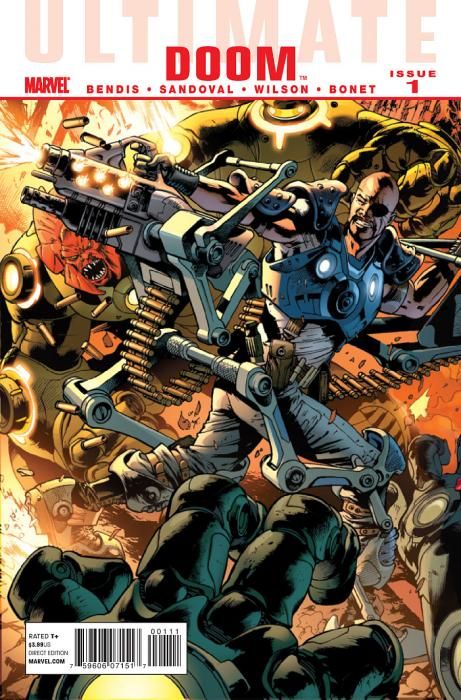Ultimate Doom is the final part in a trilogy of miniseries telling a huge, world-spanning crossover outside the main titles. Unlike the "Ultimate Galactus" trilogy ("Ultimate Secret"/"Mystery"/"Nightmare") it borrowed the idea from, though, these miniseries have not been discrete stories around a common threat -- "Ultimate Doom" is a direct continuation of "Ultimate Mystery" -- which begs the question of why it wasn't just one series in this first place.
It's a valid criticism, because as an opening issue, this performs abysmally. The issue opens in the middle of events and barrels through them at pace. We may gather that Reed is behind something sinister, but at no point do we learn what he's actually blamed for. Nor do we learn who or what Ultimate Rick Jones is, his presence being both fleeting and unexplained. Meanwhile, Spider-Woman is captured by a group of strange scientists. What she was doing when she was captured (apparently breaking into their facility) is also glossed over.
Admittedly, it's a certainty that these questions were addressed in the final issue of "Ultimate Mystery," but when there's a #1 on the cover, readers justifiably expect the start of a new story, rather than the final act of a much larger one.
If you can accept it as that, though, the issue improved dramatically. The dialogue is prime Bendis: snappy, naturalistic and idiosyncratic. The action is inventive and unexpected. The plot is fairly quick on its heels. And, in fact, the characterization is well-balanced. Worthy of particular praise are the scenes of hyper-genius Reed Richards acting like a teenage boy who got dumped. After all, that's what he is!
Sandoval's artwork has only improved since I last saw it (in "Ultimate Mystery"), and remains a perfect fit for the Ultimate Universe. It's modern and expressive, the action fluid and clear. It's interesting to note how much emotion Sandoval packs into some scenes (particularly at the book's climax) while retaining the book's action-adventure tone. The small gestures seem perfectly in sync with the larger ones. Some of the layouts leave a little to be desired, although they might be down to Bendis' directions more than anything.
Generally speaking, then, it's a mixed bag. Although technically good, it fails to deliver much of what it promises. Most of the criticisms could be eliminated by changing the issue number and title but, unfortunately, that's not the way it played out.

